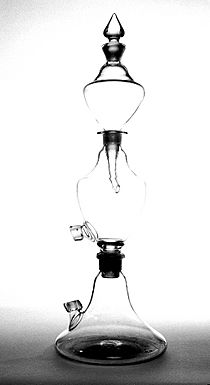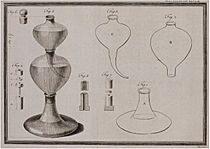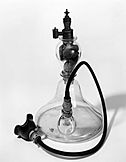John Mervin Nooth facts for kids
John Mervin Nooth (born 1737, died 1828) was an English doctor, scientist, and army officer. He studied medicine at the University of Edinburgh and became a member of the Royal Society, a famous group for scientists, in 1774. That same year, Nooth invented a special machine called the Nooth apparatus. This machine made fizzy water, which people at the time thought was good for their health. The Nooth apparatus became very popular in homes. Later, changed versions of his machine were even used in early experiments with pain relief during surgery. Nooth also served in the British Army in North America and Canada before settling in Bath, England.
Contents
Early Life and Learning
John Mervin Nooth was born on September 5, 1737, in Sturminster Newton, England. His family was well-off. He went to the University of Edinburgh and earned his medical degree in 1766. After graduating, he did his own research and traveled around Europe. He later moved to London.
Nooth's science work connected him with important people like Benjamin Franklin. In 1773, Nooth wrote to Franklin with ideas to make a machine that created static electricity better. His letter was read at the Royal Society of London. With Franklin's support, Nooth was chosen to be a Fellow of the Royal Society in 1774.
The Nooth Apparatus: Making Fizzy Water
In December 1774, Nooth shared his invention with the Royal Society. His paper was called "The description of an apparatus for impregnating water with fixed air." It described a tool that made carbonated water. At that time, carbon dioxide gas was called "fixed air."
How the Apparatus Worked
The Nooth apparatus had three glass containers stacked on top of each other.
- In the bottom container, carbon dioxide gas was made. This happened when diluted sulfuric acid reacted with pieces of chalk or marble.
- The gas then moved through a special valve into the middle container. This container held the water or liquid that was going to be carbonated.
- As the gas filled the middle container, it pushed some liquid up into the top container.
Improving on Other Inventions
Nooth's machine was based on an earlier one made by Joseph Priestley. Nooth believed his device was better because it was easier to use. He also pointed out that Priestley's machine used an animal bladder, which could make the water taste bad. Priestley was not happy about this criticism at first. However, he later agreed and even suggested Nooth's apparatus over his own.
Why Fizzy Water Was Important Back Then
In Nooth's time, people valued carbonated drinks more for their supposed health benefits than for their taste. Many thought that drinking water with "fixed air" could help with certain illnesses. For example, some believed it could help with infections or even dissolve bladder stones. The Nooth apparatus could also create water that was like natural mineral waters, which were thought to have healing powers.
Popularity and Other Uses
The Nooth apparatus became very popular in homes around the world. Later, in the 1770s, a man named Thomas Henry used a similar device to make carbonated water for sale. Even though Johann Jacob Schweppe's design eventually became more popular for commercial use, the Nooth apparatus was made until 1831.
The apparatus also found another important use. Modified versions were used to give ether to patients. This was part of some of the first experiments with general anaesthesia, which helps people feel no pain during surgery. In 1846, a dentist named James Robinson used a device that included part of a Nooth apparatus to give general anesthesia for the first time in Britain. Soon after, Peter Squire created an improved version that was successfully used during an amputation. However, these early devices were fragile and hard to use, so they were soon replaced by better ones.
Military Career and Later Life
Nooth joined the British Army in 1775. He was appointed a special doctor for the troops in North America. Around this time, he married Sarah Williams, and they had three children. Nooth served during the American Revolutionary War. He became the main supervisor for British military hospitals in America in 1779. He returned home in 1784.
Four years later, he was sent to work at hospitals in Quebec, Canada. While in Canada, Nooth stayed involved in science and medicine. He often wrote about these topics to Joseph Banks, another famous scientist. He was also named director of the Agriculture Society of Quebec in 1790. In 1798, Nooth treated Edward, Duke of Kent and Strathearn, after a horse riding accident. He later became the doctor for the Duke's household.
In 1799, Nooth's health declined, and he returned to London. Soon after arriving, he had a coughing fit and coughed up a lead bullet! His health quickly improved after that. He even wrote a paper describing this unusual event.
He went back to military service in 1804, serving in Gibraltar until 1807. His wife, Sarah, died there in 1804. When he returned, he settled in Bath, England, and married Elizabeth Willford. John Mervin Nooth died in Bath on May 3, 1828.






